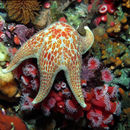Comprehensive Description
provided by Invertebrates of the Salish Sea
This star has a broad central disk and 5 short rays which taper broadly to the central disk. The rays are not bordered by marginal plates. The entire aboral surface is smooth and slippery, reddish brown with blue-gray patches or reticulations, and without spines. The thickness is about 1/3 the diameter, the madreporite can be seen. Smells distinctive--almost like garlic or burned gunpowder. Arm radius to 15 cm.
- license
- cc-by-nc-sa
- copyright
- Rosario Beach Marine Laboratory
Look Alikes
provided by Invertebrates of the Salish Sea
How to Distinguish from Similar Species: Pteraster tesselatus does not have a visible madreporite and secretes copious quantities of slime. Asterina miniata and Mediaster aequalis have clearly visible interlocking ossicles on the aboral surface.
- license
- cc-by-nc-sa
- copyright
- Rosario Beach Marine Laboratory
Comprehensive Description
provided by Invertebrates of the Salish Sea
Biology/Natural History: Prey include diatoms, sponges, bryozoans, sea pens, anemones, sea cucumbers, sea urchins, and chitons, ascidians, and fish eggs. Anemones are said to be one of its major prey items. It usually swallows its prey whole and digests them internally. The swimming anemone Stomphia sp has a strong escape response from this species; as does the purple urchin Strongylocentrotus purpuratus. Stomphia swims away, while S. purpuratus pulls in its tube feet, depresses its spines, and extends its pedicellariae; then races away. The scaleworm Arctonoe vittata is a common commensal, and the worm and the seastar are mutually attracted to one another. A parasitic barnacle Dendrogaster sp may be found inside. In Wasington, spawning is from April to August. Females release yellow eggs which are fertilized in the water.
- license
- cc-by-nc-sa
- copyright
- Rosario Beach Marine Laboratory
Habitat
provided by Invertebrates of the Salish Sea
Mostly on rocks, can also be found on sand or mud. Seems to prefer at least partially sheltered areas.
- license
- cc-by-nc-sa
- copyright
- Rosario Beach Marine Laboratory
Distribution
provided by Invertebrates of the Salish Sea
Geographical Range: Sitka, Alaska to Sacramento Reef, Baja California, Mexico; more common in the northern half of its range
- license
- cc-by-nc-sa
- copyright
- Rosario Beach Marine Laboratory
Habitat
provided by Invertebrates of the Salish Sea
Depth Range: Intertidal to 90 m
- license
- cc-by-nc-sa
- copyright
- Rosario Beach Marine Laboratory

